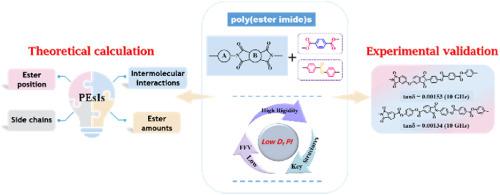Our official English website, www.x-mol.net, welcomes your
feedback! (Note: you will need to create a separate account there.)
Decoding high-frequency dielectric loss of Poly(ester imide)s: Molecular simulation and experiment validation
Polymer ( IF 4.1 ) Pub Date : 2024-06-28 , DOI: 10.1016/j.polymer.2024.127337 Xiaojie He , Songyang Zhang , Chenggang Zhang , Peng Xiao , Feng Zheng , Qinghua Lu
Polymer ( IF 4.1 ) Pub Date : 2024-06-28 , DOI: 10.1016/j.polymer.2024.127337 Xiaojie He , Songyang Zhang , Chenggang Zhang , Peng Xiao , Feng Zheng , Qinghua Lu

|
Polyimides (PIs) are essential materials for electronic and high-frequency communication applications, often face challenges with high dielectric loss. Drawing inspiration from low-dielectric-loss liquid crystal polyesters, ester groups have been introduced into PI backbones to develop poly (ester imide)s (PEsIs). This study delved into various PEsIs, aiming to reduce dielectric loss at high frequencies and to understand the molecular mechanisms behind this improvement. Selection and design of PEsIs were based on four key factors: the number of ester groups, substitution positions, side substituents and intermolecular interactions. The results indicated that the high-frequency dielectric loss of PEsIs, specifically at a frequency of 10 GHz, decreases with an increased number of ester groups. For isomeric PEsIs systems, introducing ester groups into the dianhydride part notably reduced the dielectric loss. The modes of bonding between the phenyl ring and the ester group in PI structures also impacted the dielectric loss. The configuration with an O-linked isomer showed a lower value of dielectric loss. On the other hand, introducing hydrogen bonding into PEsIs were observed to contribute a negative impact on the reduction of dielectric loss. Based on these theoretical findings, two PEsIs structures, which were identified as low-dielectric-loss PEsIs candidates, were successfully synthesized. Their dielectric loss factors at 10 GHz were measured experimentally as 0.00153 and 0.00134, thereby confirming the reliability of the theoretical results.
中文翻译:

解码聚(酯酰亚胺)的高频介电损耗:分子模拟和实验验证
聚酰亚胺 (PI) 是电子和高频通信应用的重要材料,通常面临高介电损耗的挑战。受低介电损耗液晶聚酯的启发,将酯基引入 PI 主链中,开发出聚(酯酰亚胺)(PEsIs)。这项研究深入研究了各种 PEsI,旨在降低高频介电损耗并了解这种改进背后的分子机制。 PEsIs 的选择和设计基于四个关键因素:酯基的数量、取代位置、侧取代基和分子间相互作用。结果表明,PEsI 的高频介电损耗,特别是在 10 GHz 频率下,随着酯基数量的增加而降低。对于异构PEsIs体系,在二酐部分引入酯基可显着降低介电损耗。 PI结构中苯环和酯基之间的键合方式也会影响介电损耗。 O-连接异构体的构型表现出较低的介电损耗值。另一方面,观察到在 PEsI 中引入氢键会对介电损耗的降低产生负面影响。基于这些理论发现,成功合成了两种 PEsIs 结构,它们被确定为低介电损耗 PEsIs 候选材料。实验测得它们在10GHz下的介电损耗因数分别为0.00153和0.00134,从而证实了理论结果的可靠性。
更新日期:2024-06-28
中文翻译:

解码聚(酯酰亚胺)的高频介电损耗:分子模拟和实验验证
聚酰亚胺 (PI) 是电子和高频通信应用的重要材料,通常面临高介电损耗的挑战。受低介电损耗液晶聚酯的启发,将酯基引入 PI 主链中,开发出聚(酯酰亚胺)(PEsIs)。这项研究深入研究了各种 PEsI,旨在降低高频介电损耗并了解这种改进背后的分子机制。 PEsIs 的选择和设计基于四个关键因素:酯基的数量、取代位置、侧取代基和分子间相互作用。结果表明,PEsI 的高频介电损耗,特别是在 10 GHz 频率下,随着酯基数量的增加而降低。对于异构PEsIs体系,在二酐部分引入酯基可显着降低介电损耗。 PI结构中苯环和酯基之间的键合方式也会影响介电损耗。 O-连接异构体的构型表现出较低的介电损耗值。另一方面,观察到在 PEsI 中引入氢键会对介电损耗的降低产生负面影响。基于这些理论发现,成功合成了两种 PEsIs 结构,它们被确定为低介电损耗 PEsIs 候选材料。实验测得它们在10GHz下的介电损耗因数分别为0.00153和0.00134,从而证实了理论结果的可靠性。











































 京公网安备 11010802027423号
京公网安备 11010802027423号